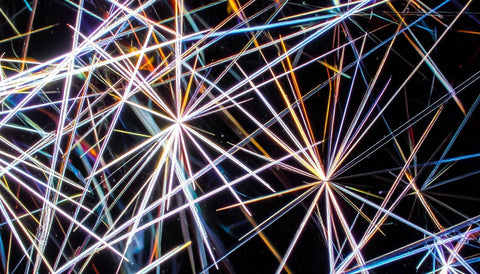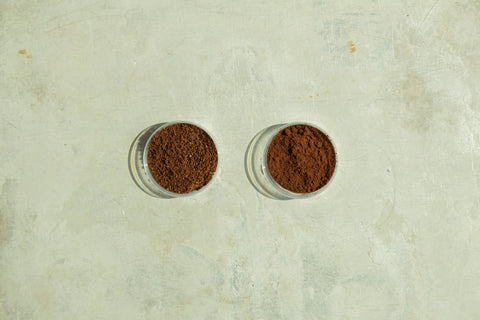Hidden in every cup of coffee is a fascinating molecule: caffeine.
Much more than a simple "boost," it is a psychoactive stimulant that acts at the cellular level, alters our neurochemistry, influences our performance, and can, in high doses, disrupt our nervous system.
A dive into the biochemical twists and turns of this substance that billions of humans consume every day.
Structure and origin: a plant alkaloid

Caffeine (C₈H₁₀N₄O₂) belongs to the methylxanthine family of alkaloids naturally produced by certain plants as a defense mechanism against insects.
It is found in more than 60 plant species, including coffee seeds (Coffea arabica, Coffea canephora), tea leaves (Camellia sinensis), guarana, mate, and cocoa beans.
Its structure is similar to that of adenosine, a key neuromodulator involved in regulating sleep and alertness. It is precisely this molecular similarity that allows it to act so effectively on our brains.

[Coffee containing caffeine crystals under the microscope.]
Mechanism of action
Once ingested, caffeine is rapidly absorbed from the small intestine, reaching its peak plasma concentration within 30 to 90 minutes. It readily crosses the blood-brain barrier, allowing it to act directly on the central nervous system.

[Microscopic magnification of intestinal villi. The inner wall of the intestinal mucosa.]
Its main effect?
Block adenosine receptors (A1 and A2A):
Normally, adenosine builds up throughout the day, signaling to the brain that it's time to slow down. By preventing this molecule from binding to its receptors, caffeine slows the feeling of fatigue and improves attention, alertness, and working memory.
This blockage also leads to an indirect increase in dopamine in certain brain regions, which may explain the mildly euphoric effect some people experience after a good cup.

[Motor neuron under a microscope in a laboratory.]
Metabolism and duration of action
Caffeine is metabolized primarily by the CYP1A2 enzyme in the liver. Its duration of effect varies considerably from person to person (ranging from 2 to 8 hours), depending on factors such as genetics, age, oral contraceptive use, and pregnancy.
Some people are "fast metabolizers," meaning caffeine is cleared from their bodies quickly, while others are "slow metabolizers" and experience its effects for a longer time, including insomnia, palpitations, or anxiety.
Desired effects
In low or moderate doses (50 to 200 mg), caffeine improves concentration, alertness, motor coordination, and physical endurance. It is also permitted in competitive sports, provided that certain limits are not exceeded.
But in excess (more than 400 mg/day in adults), it can cause:
- Tachycardia
- Nervousness and agitation
- Sleep disorders
- Mild diuretic effects
- Withdrawal syndrome: headaches, fatigue, irritability
In adolescents, whose nervous systems are still developing, Health Canada recommends not exceeding 2.5 mg/kg of body weight per day.

A molecule with documented benefits
Robust epidemiological studies suggest that caffeine, when consumed in non-ultra-processed products such as coffee or tea, is associated with:
- Reducing the risk of Parkinson's and Alzheimer's
- Better insulin sensitivity
- Reducing the risk of certain cancers
- Improving physical performance
(via increased mobilization of free fatty acids)
* Be careful, however, of the synergistic effect with other compounds, such as catechins in green tea or theobromine in cocoa, which can modulate its effects.
 [Human blood under a microscope. You can see the erythrocytes, or red blood cells.]
[Human blood under a microscope. You can see the erythrocytes, or red blood cells.]
And in the cup, how much caffeine is there?
Now with all this information, you must surely be asking yourself this exact question: “ How much caffeine is in my coffee in the end? "It's not that simple. Each extraction method results in different caffeine levels in the cup.
The strength depends mainly on the amount of coffee used, the water-to-coffee ratio, and the grind. Since caffeine is highly soluble, much of it is extracted quickly, so a longer infusion can extract more. In short, the dose and ratio have a much greater impact on the final result than a few seconds of extraction.
caffeine content vs. extraction method (approximately)
| Espresso ( ~ 30 ml) |
~ 60 – 65 mg |
| Pour-over / Infusion (~240 ml / 8 oz) |
95 – 185 mg |
| Coffee maker (~240 ml / 8 oz) |
95 mg on average (70 – 125 mg) |
| French Press (~240 ml / 8 oz) |
~ 80 – 120 mg (can reach + 135 mg) |
| Cold Brew (~240 ml / 8 oz) |
> 150 mg (depending on concentration) |

[Caffeine crystals under polarized light.]
Conclusion
Caffeine is a complex and powerful molecule.
Used properly, it can be an ally for cognition, performance, and mental well-being. But like any active ingredient, it should be consumed in moderation. It's not a magic potion or a substitute for rest or a healthy lifestyle. It's a tool, and like any tool, its value depends on the person wielding it.
— Marie-Claire Marquis
Research
Mediagraphy
Nehlig, A. (2016). “Interindividual differences in caffeine metabolism and factors driving caffeine consumption.” Pharmacological Reviews. Health Canada (2020). “Caffeine: information and recommendations.” EFSA (2015). “Scientific Opinion on the safety of caffeine.” Harvard Medical School (2023). “Caffeine and health: What’s the buzz?” Real-Time Source: The Spruce Eats, How Much Caffeine Is in a Cup of Coffee? (2024) — data on drip, French Press, Aeropress, espresso. CoffeExplore.com, Pour Over Coffee Caffeine: Vs. Espresso, Drip & French Press (2025) — pour-over range.



Comments (0)
There are no comments for this article. Be the first one to leave a message!